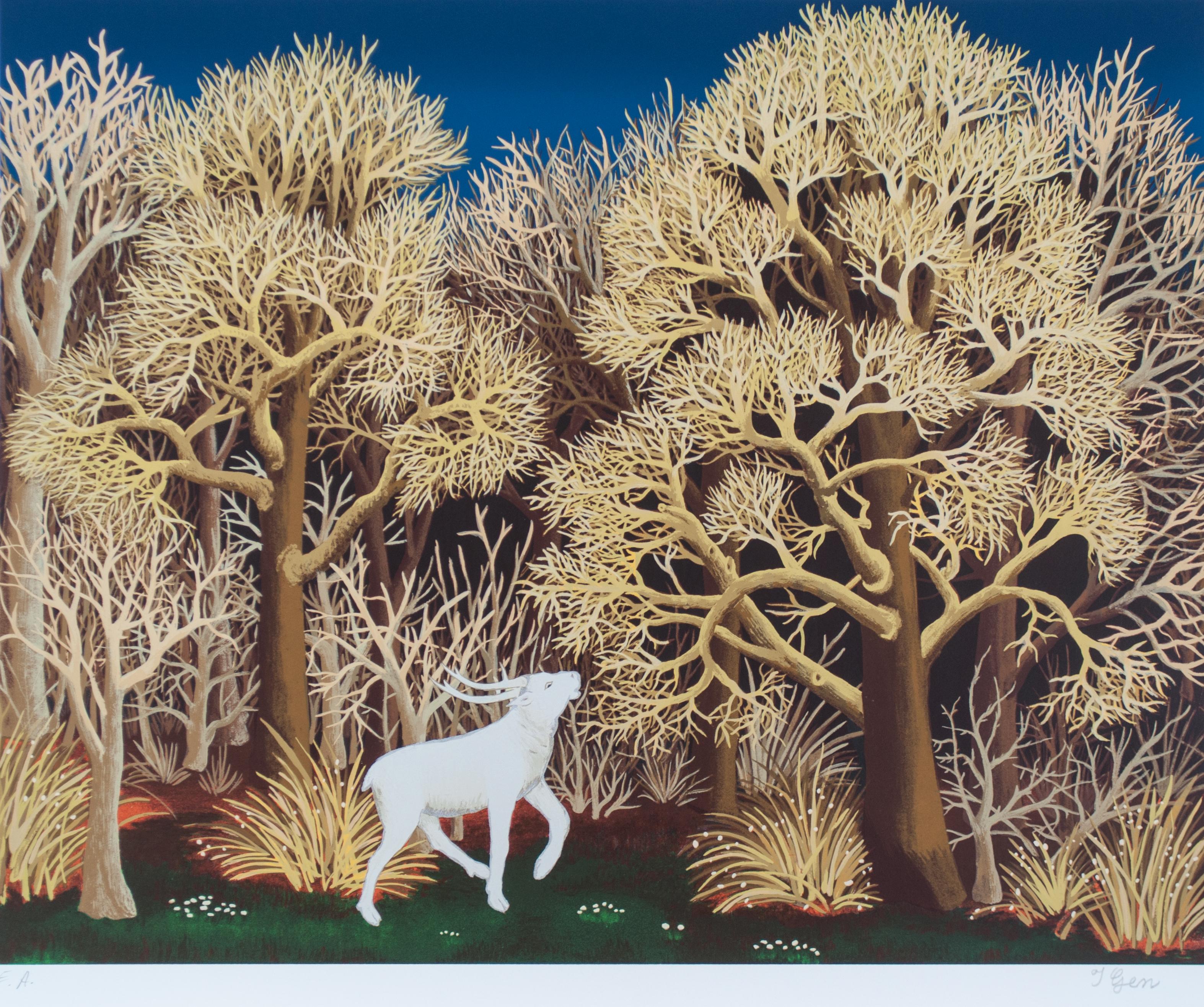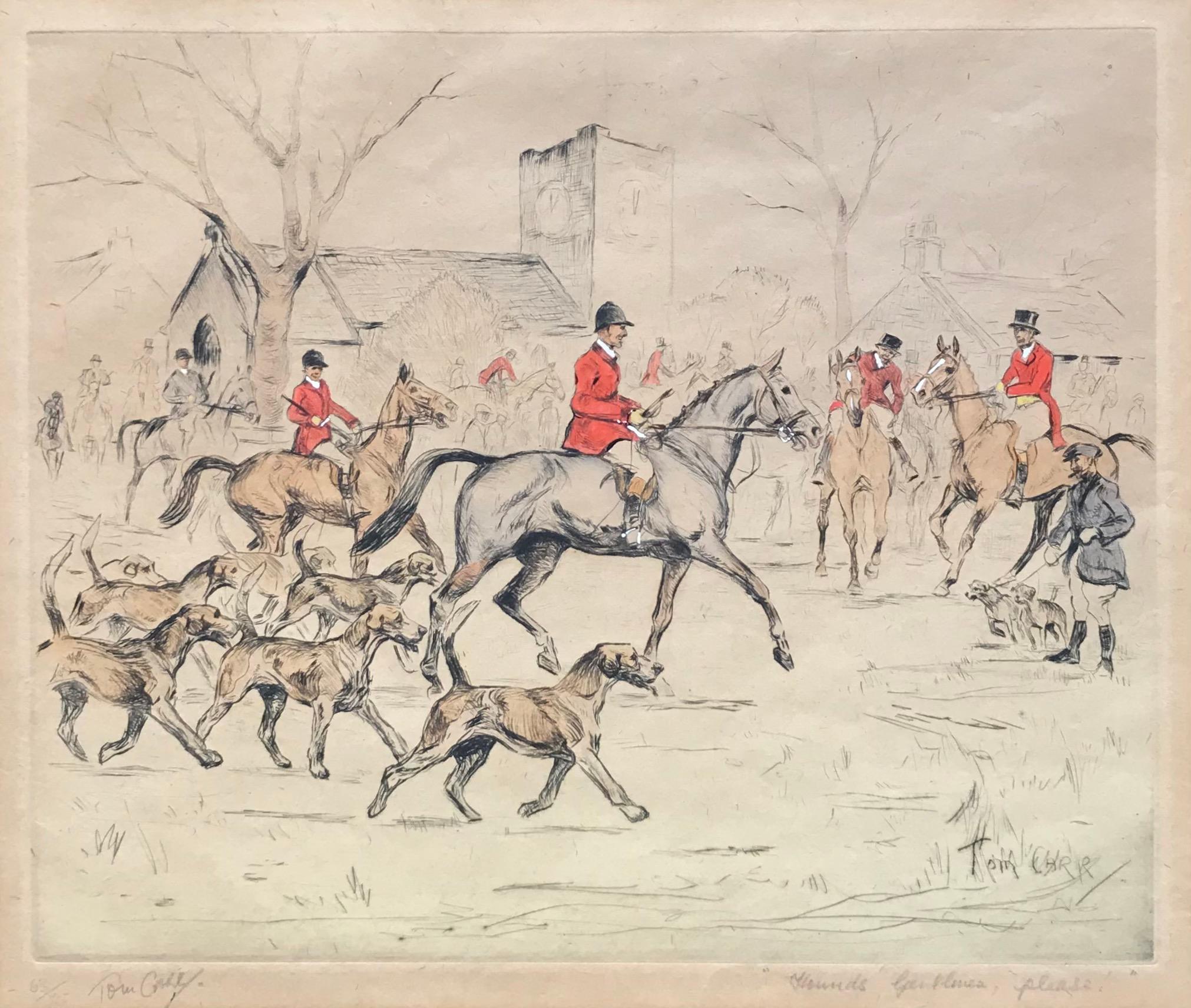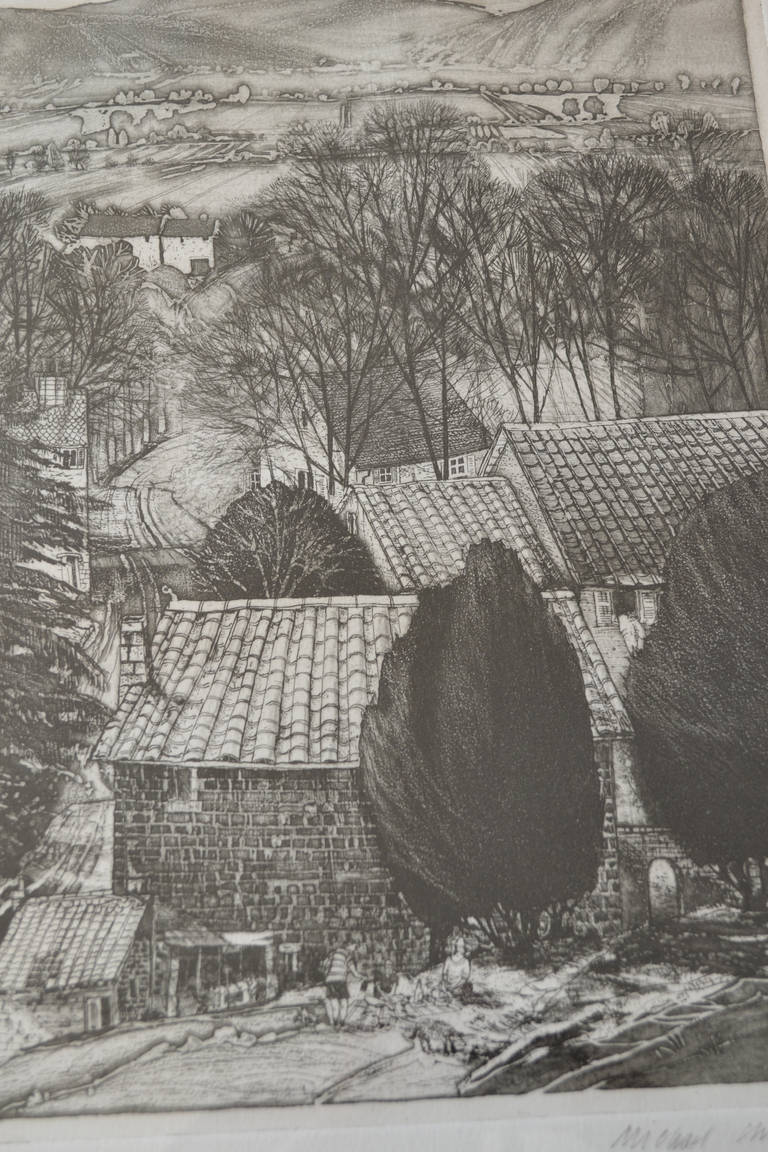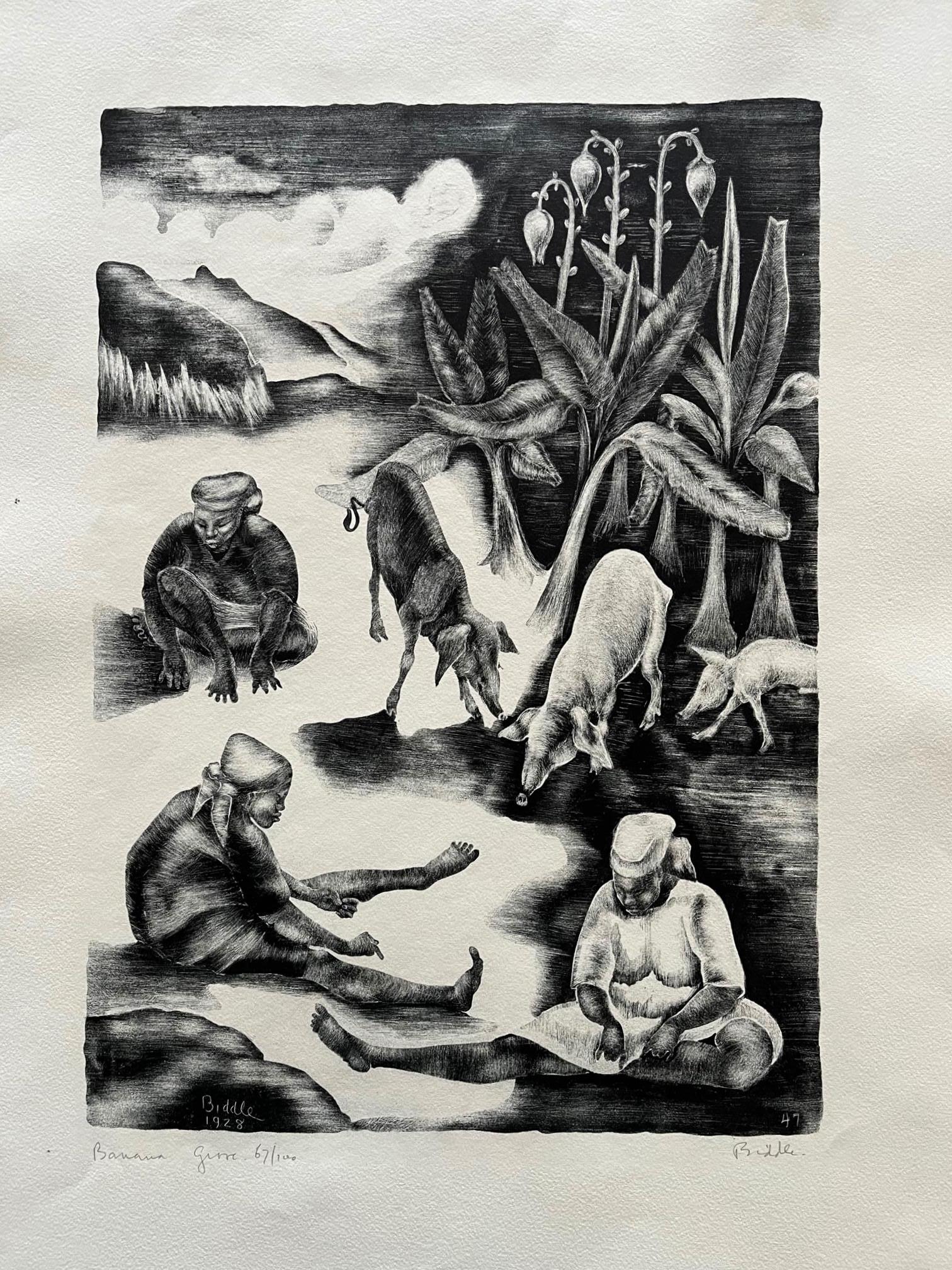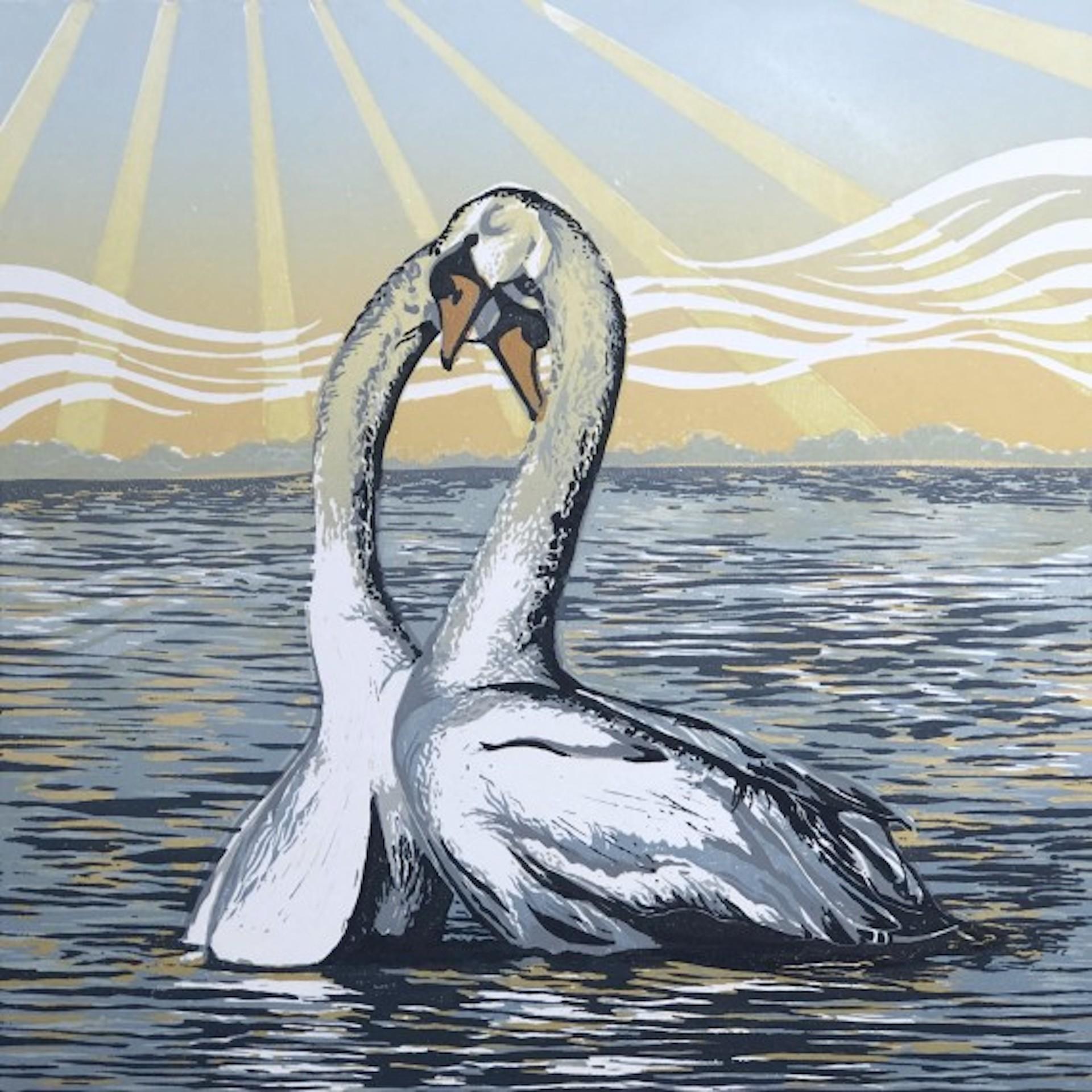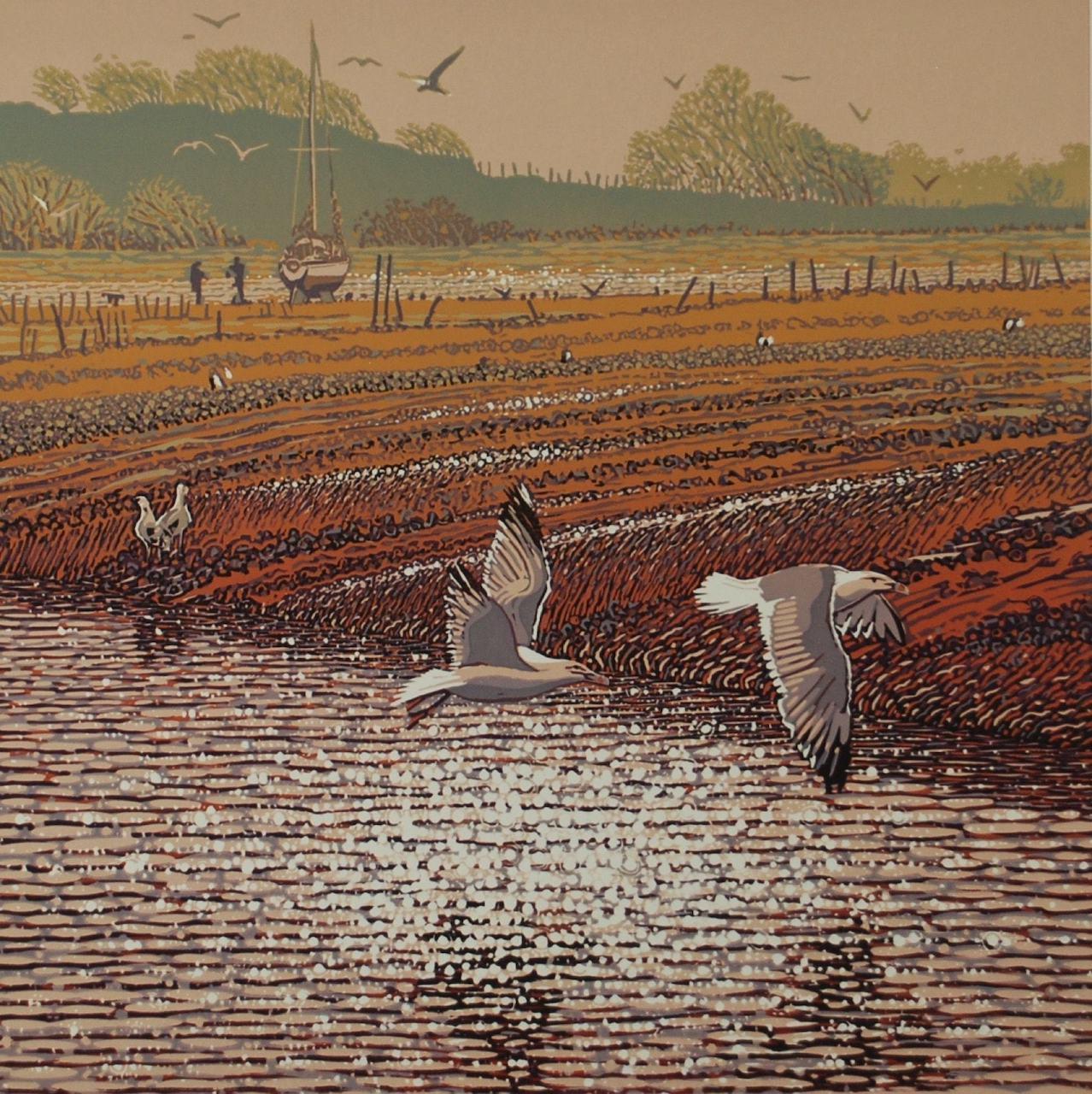Items Similar to Three Herons - At the flaming lake -
Want more images or videos?
Request additional images or videos from the seller
1 of 5
Rudolf HayderThree Herons - At the flaming lake -1st half of the 20th century
1st half of the 20th century
About the Item
Rudolf Hayder (active in the 1st half of the 20th century), Heron. Color woodcut on thin Japanese paper, 24 x 29 cm (image), 29 x 36 cm (sheet size), signed by hand at lower right "R. Hayder" and titled by hand as "Reiher". Lower left inscribed by hand "Orig.[inal] woodcut, hand print".
- A little bit stained in the margins and very occasionally in the image, minimal hole above the signature, traces of creasing. At the back side's margins with remnants of an old mounting.
About the artwork
In the context of French Japonism, the color woodblock print, which was widespread in the Asian region, was rediscovered for Western art. The artists of the time, such as Édouard Manet, Claude Monet, Edgar Degas, Paul Gauguin and Vincent van Gogh, were inspired not only by the cultural influence, but also by the two-dimensionality of the pictorial spaces. Thus, color woodcuts became an important moment in the development of the modern pictorial concept founded by Impressionism.
In Rudolf Hayder's "Herons", too, the two-dimensionality of the pictorial space is decisive for the pictorial effect. The herons, surrounded by reeds, are framed by the yellow background of the lake, followed by the dark blue-greenish stripe of the opposite shore and, above it, the sky in a lighter blue-green. Formally, it is a sequence of planes, but the two-dimensionality of the motif creates a spatial effect. This spatiality in the surface creates an intense pictorial effect. Hayder intensifies this effect with the blazing lake. In terms of color, the water becomes a sunset. The yellow turns reddish brown toward the shore, then fades to brownish red, while the shore is a watery turquoise. There is something ephemeral about this color mood, as evidenced by the masterful water reflections on the reeds and the legs of the herons.
In Japan, the heron is considered very important. It is said to be able to live over 1000 years. Therefore, it is considered a symbol of longevity. It is also said to choose only one partner in life, which makes it a symbol of fidelity.
Without directly addressing these meanings, Hayder develops a relationship between the herons. On the left, two of the birds stand with their necks stretched, while the animal opposite has its head tucked in. This creates a dialogicity that the viewer cannot decipher, which in turn is fueled by the flaming water.
GERMAN VERSION
Rudolf Hayder (tätig in der 1. Hälfte 20. Jh.), Reiher. Farbholzschnitt auf dünnem Japanpapier, 24 x 29 cm (Darstellung), 29 x 36 cm (Blattmaß), rechts unten mit „R. Hayder“ handsigniert und als „Reiher“ handbetitelt. Links unten handvermerkt „Orig.[inal] Holzschnitt, Handabdruck“.
- In den Randbereichen etwas und sehr vereinzelt in der Darstellung stockfleckig, minimales Loch über der Signatur, Knickspuren. Rückseitig an den Rändern mit Falzresten einer alten Montage.
zum Kunstwerk
Im Rahmen des französischen Japonismus wurde der im asiatischen Raum verbreitete Farbholzschnitt für die westliche Kunst wiederentdeckt. Die damaligen Künstler, wie Édouard Manet, Claude Monet, Edgar Degas, Paul Gauguin und Vincent van Gogh, inspirierte neben der kulturellen Prägung, vor allem die Flächigkeit der Bildräume. Damit wurden die Farbholzschnitte zum wichtigen Moment bei der Ausprägung der vom Impressionismus begründeten modernen Bildauffassung.
Und auch bei den „Reihern“ von Rudolf Hayder ist die flächenmäßige Entwicklung des Bildraums für die Bildwirkung entscheidend. Die vom Schilf umgebenden Reiher werden vom gelben Fond des Sees hinterfangen, an den sich der dunkle blaugrünliche Streifen des anderen Ufers und darüber der in hellerem Blaugrün gehaltenen Himmel anschließen. Formal gesehen handelt es sich um eine Abfolge von Flächen, die durch die motivische Rückbindung allerdings eine Raumwirkung in der Flächigkeit entfalten. Diese Räumlichkeit in der Fläche erzeugt eine intensive Bildwirkung. Hayder steigert diese Wirkung durch den aufflammenden See. Farblich wird das Wasser zu einem Sonnenuntergang. Das Gelb färbt sich zum Ufer hin rotbraun, um dann in einem Braunrot auszuklingen, während das Ufer ein wasserartiges Türkis aufweist. Dass diese Farbstimmung etwas Ephemeres hat, wird von den meisterhaft ausgeführten Wasserreflexionen des Schilfs und der Beine der Reiher veranschaulicht.
In Japan wird dem Reiher eine wichtige Bedeutung beigemessen. Ihm wurde nachgesagt, über 1000 Jahre alt werden zu können. Daher gilt er als Symbol der Langlebigkeit. Zudem heißt es, er würde im Leben nur einen Partner wählen, weshalb er auch für die Treue einsteht.
Ohne diese Bedeutungen direkt aufzugreifen, entwickelt Hayder eine Beziehung der Reiher untereinander. Links stehen zwei der Vögel mit gerecktem Hals, während das Tier ihnen gegenüber seinen Kopf eingezogen hat. Es entsteht eine für den Betrachter nicht zu entschlüsseln Dialogizität, die wiederum vom flammenden Wasser befeuert wird.
- Creator:Rudolf Hayder (German)
- Creation Year:1st half of the 20th century
- Dimensions:Height: 9.45 in (24 cm)Width: 11.42 in (29 cm)
- Movement & Style:
- Period:
- Condition:
- Gallery Location:Berlin, DE
- Reference Number:1stDibs: LU2438212310042

About the Seller
5.0
Vetted Seller
These experienced sellers undergo a comprehensive evaluation by our team of in-house experts.
Established in 2014
1stDibs seller since 2023
7 sales on 1stDibs
Typical response time: 7 hours
- ShippingRetrieving quote...Ships From: Berlin, Germany
- Return PolicyA return for this item may be initiated within 14 days of delivery.
More From This SellerView All
- Agony - The architecture of decay -Located in Berlin, DEJörg Olberg (*1956 Dresden), Agony, 1987. etching, E.A. (edition of 30), 24 x 17 cm (image), 46 x 37 cm (sheet), each signed in pencil lower right "Olberg" and dated "IX [19]87", inscribed lower left "E.A. [Epreuve d'Artiste]". - minimal crease and dust stains in the broad margin - The architecture of decay - About the artwork Jörg Olberg draws here the sum of his artistic study of the Berlin ruins, which were still present in the cityscape well into the 80s. With his work "Agony" he creates an allegory of decay. Positioned in the landscape of ruins, a ruined house grows before the viewer, rising like the Tower of Babel into the sky, its roof and gable brightly illuminated by the sun. But already the roof shows mostly only the rafters, and as the gaze is drawn further down, the building visibly disintegrates, the beams protruding in all directions looking like splintered bones. Slowly but inexorably - in agony - the house will collapse in on itself and become nothing more than the burial mound of itself. At the same time, the small-scale stone composition and the plaster form a pattern-like ornamentation of decay. The tension in the picture is fed by the counter-movement of growth and collapse, which is heightened by the dramatic formation of clouds. The swirls of clouds are reminiscent of a world landscape...Category
1980s Realist Figurative Prints
MaterialsPaper, Etching
- View of a coastal town / - The Pilgrim's View -Located in Berlin, DEAlbert Ernst (1909 Fronhofen - 1996 Hamburg), View of a Coastal Town, etching, 30 x 37 cm (picture), 45 x 50.5 cm (frame), signed in pencil lower right "Albert Ernst", framed under g...Category
Mid-20th Century Realist Landscape Prints
MaterialsEtching
- Evening - The depth of the visible -Located in Berlin, DEMax Clarenbach (1880 Neuss - Cologne 1952), Evening. Etching, 18 x 41 cm (platemark), 33.5 x 57 cm (frame), inscribed "Abend" in pencil at lower left, signed and dated "M. Clarenbach. 28.III.[19]09". Framed and mounted under glass. - Somewhat browned and slightly foxed. About the artwork The horizontally elongated etching depicts the panoramic view of a small town as seen from the other side of the river. There are gabled houses on the left and a mighty church spire on the right. The bourgeois houses and the large religious building indicate the urban character. These buildings are rendered in dark tones to emphasise the lighter row of houses in the centre of the picture, closer to the water. The chiaroscuro contrast creates two parallel planes that open up a space for the imagination of what the city could be. The imagination is stimulated by the almost entirely dark, barely recognisable buildings, while the arm of the river leading into the city further stimulates the imagination. However, as the silhouette of the city as a whole is reflected in the water, the parallel planes are perceived as a band of houses that stretches across the entire horizontality of the etching and seems to continue beyond the borders of the picture. The reflection has almost the same intensity as the houses themselves, so that the band of buildings merges with their reflection to form the dominant formal unit of the picture. Only the parallel horizontal hatching creates the convincing impression of seeing water, demonstrating Max Clarenbach's mastery of the etching needle. The water is completely motionless, the reflection unclouded by the slightest movement of the waves, creating a symmetry within the formal unity of the cityscape and its reflection that goes beyond the motif of a mere cityscape. A pictorial order is established that integrates everything in the picture and has a metaphysical character as a structure of order that transcends the individual things. This pictorial order is not only relevant in the pictorial world, but the picture itself reveals the order of the reality it depicts. Revealing the metaphysical order of reality in the structures of its visibility is what drives Clarenbach as an artist and motivates him to return to the same circle of motifs. The symmetry described is at the same time inherent an asymmetry that is a reflection on art: While the real cityscape is cut off at the top of the picture, two chimneys and above all the church tower are not visible, the reflection illustrates reality in its entirety. The reflection occupies a much larger space in the picture than reality itself. Since antiquity, art has been understood primarily as a reflection of reality, but here Clarenbach makes it clear that art is not a mere appearance, which can at best be a reflection of reality, but that art has the potential to reveal reality itself. The revealed structure of order is by no means purely formalistic; it appears at the same time as the mood of the landscape. The picture is filled with an almost sacred silence. Nothing in the picture evokes a sound, and there is complete stillness. There are no people in Clarenbach's landscape paintings to bring action into the picture. Not even we ourselves are assigned a viewing position in the picture, so that we do not become thematic subjects of action. Clarenbach also refrains from depicting technical achievements. The absence of man and technology creates an atmosphere of timelessness. Even if the specific date proves that Clarenbach is depicting something that happened before his eyes, without the date we would not be able to say which decade, or even which century, we are in. The motionless stillness, then, does not result in time being frozen in the picture, but rather in a timeless eternity that is nevertheless, as the title "Abend" (evening), added by Clarenbach himself, makes clear, a phenomenon of transition. The landscape of the stalls is about to be completely plunged into darkness, the buildings behind it only faintly discernible. The slightly darkened state of the sheet is in keeping with this transitional quality, which also lends the scene a sepia quality that underlines its timelessness. And yet the depiction is tied to a very specific time. Clarenbach dates the picture to the evening of 28 March 1909, which does not refer to the making of the etching, but to the capture of the landscape's essence in the landscape itself. If the real landscape is thus in a state of transition, and therefore something ephemeral, art reveals its true nature in that reality, subject to the flow of phenomena, is transferred to an eternal moment, subject to a supra-temporal structure of order - revealed by art. Despite this supratemporality, the picture also shows the harbingers of night as the coming darkening of the world, which gives the picture a deeply melancholy quality, enhanced by the browning of the leaf. It is the philosophical content and the lyrical-melancholic effect of the graphic that give it its enchanting power. Once we are immersed in the image, it literally takes a jerk to disengage from it. This etching, so characteristic of Max Clarenbach's art, is - not least because of its dimensions - a major work in his graphic oeuvre. About the artist Born into poverty and orphaned at an early age, the artistically gifted young Max Clarenbach was discovered by Andreas Achenbach and admitted to the Düsseldorf Art Academy at the age of 13. "Completely penniless, I worked for an uncle in a cardboard factory in the evenings to pay for my studies.” - Max Clarenbach At the academy he studied under Arthur Kampf, among others, and in 1897 was accepted into Eugen Dücker...Category
Early 1900s Realist Landscape Prints
MaterialsEtching
- Memory and Present - The flowing space of memory -Located in Berlin, DEKarl Ludwig Mordstein (1937 Füssen - 2006 Wilszhofen), Memory and Present, 1983. Color etching, copy 41/50, 22.5 x 28 cm (image), 40 x 45 cm (sheet), 43 x 48 cm (frame), titled, numbered, monogrammed and dated with pencil. Framed behind glass. - in very good condition - The flowing space of memory - About the artwork On an implied horizon line, a dog-like animal has risen on its hind legs and is about to jump over some kind of hurdle. To the left, a small flag is waving in the wind. The animal and the flag point forward, toward the reader, into the future. The flagpole, however, bends backwards in the opposite direction, corresponding to the impulse of movement of the sign-like formations in the "sky". The title of this work by Mordstein is also revealing. It reads "Memory and Presence" and thematizes the system of signs above the animal as memory. It is therefore not so much a sky as the space of remembering consciousness. Memory moves into the past, but comes from the future and begins where the animal first moves. Here, Mordstein develops a subtle pictorial philosophy about the character of time and the structure of memory, in which the system of signs representing the content of consciousness is inspired by the pictorial language of Paul Klee, whom Mordstein continues to think about in his own way. About the artist After graduating from the Werkkunstschule in Augsburg, Karl Mordstein worked as a commercial artist in Munich before becoming a freelance artist and concentrating entirely on his own creations. In 1970 Mordstein married the sculptor Sinen Thalheimer and the artist couple moved to Starnberg. In 1972, Mordstein had his first solo exhibition in Munich, which marked the beginning of an active international exhibition career that lasted for decades. From 1987 the couple lived on the Hollerberg in Wilzhofen. "It is certainly not wrong to recognize in the impression of his calmly floating color drawings the expression of a state of mind that owes itself precisely to this conscious turning away from the hectic art market: concentrated serenity. It is not a changing state of mind, but an empathy with the supra-individual rhythms of creation, the perpetual genesis in the natural cycle of becoming and passing, which is expressed in them." - Stefan Tolksdorf Selected Bibliography Karl Mordstein. Aquarelle, Gouachen 1972 – 1975, Galerie Angst und Orny, München 1975. Juliane Roh: Karl Mordstein. Bilder, Paintings 1976 – 79, Frankfurt a. M. 1979. Siegfried Salzmann (Text): Karl Mordstein. Arbeiten auf Papier, Galerie Dorothea van der Koelen, Mainz 1982. Galerie Heimeshoff (Hrsg.): Karl Mordstein. "Seelen-Notate"; Bilder, Arbeiten auf Papier, Bildkästen; 1985 – 1988, Essen 1988. Stefan Tolksdorf (Text): Lebenszeichen. Mordstein, Karl und Sinen Thalheimer, Essen 2009. GERMAN VERSION Karl Ludwig Mordstein (1937 Füssen – 2006 Wilszhofen), Erinnerung und Gegenwart, 1983. Farbradierung, Exemplar 41/50, 22,5 x 28 cm (Darstellung), 40 x 45 cm (Blattgröße), 43 x 48 cm (Rahmen), in Blei betitelt, nummeriert, monogrammiert und datiert. Hinter Glas gerahmt. - in sehr gutem Erhaltungszustand - Der fließende Raum der Erinnerung - zum Kunstwerk Auf einer angedeuteten Horizontlinie hat sich ein hundeartiges Tier auf die Hinterläufe erhoben und setzt zum Sprung an, um eine Art Hürde zu überwinden. Links daneben weht eine kleine Fahne im Wind. Das Tier und die Fahne weisen in Leserichtung nach vorne, in die Zukunft hinein. Die Fahnenstange biegt sich allerdings in die gegenteilige Richtung nach hinten und entspricht damit dem Bewegungsimpuls der zeichenhaften Gebilde am ‚Himmel‘. Auch bei diesem Werk Mordsteins ist der Titel aufschlussreich. Er lautet „Erinnerung u. Gegenwart“ und thematisiert das Zeichensystem über dem Tier als Erinnerung. Daher handelt es sich weniger um einen Himmel als um den Raum des erinnernden Bewusstseins. Die Erinnerung zieht in die Vergangenheit, kommt aber von der Zukunft her und beginnt dort, wohin sich das Tier erst bewegt. Mordstein entwickelt hier eine subtile Bildphilosophie über den Charakter der Zeit und die Struktur der Erinnerung, wobei das für den Bewusstseinsinhalt stehende Zeichensystem von der Bildsprache Plau Klees inspiriert ist, den Mordstein hier auf seine Art...Category
1980s Abstract Abstract Prints
MaterialsEtching
- Indistinct Clear - Fluctuating ambivalence -Located in Berlin, DEKarl Ludwig Mordstein (1937 Füssen - 2006 Wilszhofen), Undeutlicher deutlich, 1982. Color etching, e.a. (Epreuve d'artiste) 4/9, 22.5 x 28 cm (image), 40 x 45 cm (sheet), 43 x 48 cm ...Category
1980s Abstract Abstract Prints
MaterialsEtching
- The Lost TraceBy Ernst FuchsLocated in Berlin, DEErnst Fuchs (1930 Vienna - 2015 ibid), The Lost Trace, 1972. Vernis mou and aquatint etching, 46.8 x 36.4 cm (plate), 66 x 50 cm (sheet), 69.5 x 53.5 cm (frame), WVZ Hartmann no. 185...Category
1970s Surrealist Figurative Prints
MaterialsEtching
You May Also Like
- SpringLocated in Ljubljana, SISpring. Original color silkscreen, unknown year. Edition of E.A. (artist’s proof) signed and numbered impression on Arches paper. Ivan Generalić was a Croatian artist and a pioneer o...Category
Late 20th Century Realist Landscape Prints
MaterialsScreen
- Hounds Gentlemen Please by Tom Carr - Engraving 26x31 cmLocated in Geneva, CHWork on paper Ed: 63/75Category
Mid-20th Century Realist Animal Prints
MaterialsEngraving
- Italian Summer, Framed Etching by Michael ChapmanBy Michael James ChaplinLocated in Brecon, PowysEtching from the studio of this acclaimed British Watercolorist. Good condition. Image 15.5" x 11.5" English artist Michael Chaplin is a Member of the Royal Watercolor Society, pa...Category
1990s Realist Landscape Prints
MaterialsEtching
- Banana GroveBy George BiddleLocated in New York, NYGeorge Biddle (1885-1973), Banana Grove, lithograph, 1928. Signed, titled and numbered in pencil [also annotated in the plate “Biddle/1928, lower right “47). References: Pennigar 81, Trotter 47. In excellent condition, the full sheet, on cream wove BFK RIVES paper, with their (partial) watermark. 12 1/2 x 9, the sheet 20 x 16, archival mounting (non attached mylar hinging between acid free board, glassine cover). A fine fresh rich impression in pristine condition. After Groton, Harvard College...Category
1920s Realist Animal Prints
MaterialsLithograph
- Just You And I, Lisa Benson, Limited Edition Print, Swan Artwork, Animal ArtworkLocated in Deddington, GBJust You And I by Lisa Benson [2020] limited edition Linocut print Edition of 9 Image size: H:30 cm x W:30 cm Complete Size of Unframed Work: H:42.5 cm...Category
21st Century and Contemporary Realist Animal Prints
MaterialsLinocut
- Dad's Estuary View, Mark A Pearce, Limited Edition Print, Rural Art, Happy ArtBy Mark A PearceLocated in Deddington, GBMark A Pearce Dad’s Estuary View Limited Edition Reduction Linocut Edition of 58 Size: H 66cm x W 66cm x D 0.1cm Sold Unframed Please note that in situ images are purely an indicatio...Category
21st Century and Contemporary Realist Landscape Prints
MaterialsPaper, Linocut
